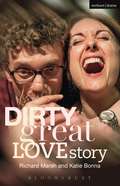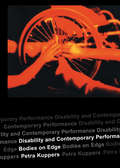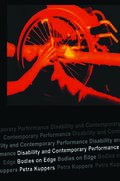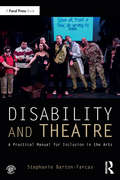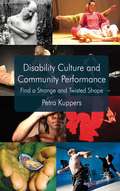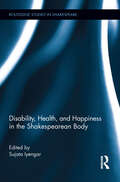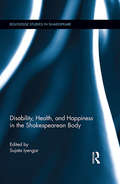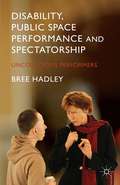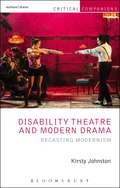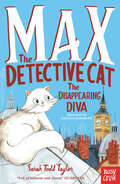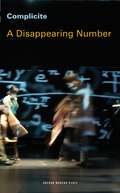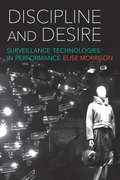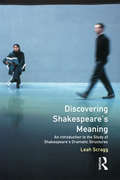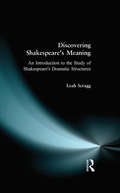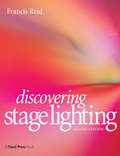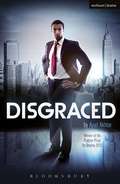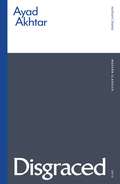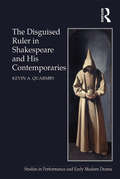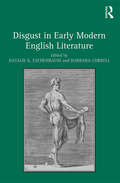- Table View
- List View
Dirty Great Love Story (Modern Plays)
by Richard Marsh Katie BonnaTwo hopeful, hapless romantics get drunk, get it on, and then get the hell away from each other. In her eyes, he's a mistake. A mistake who keeps turning up at parties. In his eyes, she's perfect. He's short-sighted.This achingly funny, romantic catastrophe fuses poetry and prose to ask can a one-night stand last a lifetime.A very human tale of good intentions and bad timing. Winner of 2012 Fringe First (for innovation and outstanding new writing at the Edinburgh Festival Fringe), Dirty Great Love Story is a tale of the chance of love in a one-night stand.
Disability and Contemporary Performance: Bodies on the Edge
by Petra KuppersDisability and Contemporary Performance presents a remarkable challenge to existing assumptions about disability and artistic practice. In particular, it explores where cultural knowledge about disability leaves off, and the lived experience of difference begins. Petra Kuppers, herself an award-winning artist and theorist, investigates the ways in which disabled performers challenge, change and work with current stereotypes through their work. She explores freak show fantasies and 'medical theatre' as well as live art, webwork, theatre, dance, photography and installations, to cast an entirely new light on contemporary identity politics and aesthetics. This is an outstanding exploration of some of the most pressing issues in performance, cultural and disability studies today, written by a leading practitioner and critic.
Disability and Contemporary Performance: Bodies on the Edge
by Petra KuppersDisability and Contemporary Performance presents a remarkable challenge to existing assumptions about disability and artistic practice. In particular, it explores where cultural knowledge about disability leaves off, and the lived experience of difference begins. Petra Kuppers, herself an award-winning artist and theorist, investigates the ways in which disabled performers challenge, change and work with current stereotypes through their work. She explores freak show fantasies and 'medical theatre' as well as live art, webwork, theatre, dance, photography and installations, to cast an entirely new light on contemporary identity politics and aesthetics. This is an outstanding exploration of some of the most pressing issues in performance, cultural and disability studies today, written by a leading practitioner and critic.
Disability and Theatre: A Practical Manual for Inclusion in the Arts
by Stephanie Barton FarcasDisability and Theatre: A Practical Manual for Inclusion in the Arts is a step-by step manual on how to create inclusive theatre, including how and where to find actors, how to publicize productions, run rehearsals, act intricate scenes like fights and battles, work with unions, contracts, and agents, and deal with technical issues. This practical information was born from the author’s 16 years of running the first inclusive theatre company in New York City, and is applicable to any performance level: children’s theatre, community theatre, regional theatre, touring companies, Broadway, and academic theatre. This book features anecdotal case studies that emphasize problem solving, real-world application, and realistic action plans. A comprehensive Companion Website provides additional guidelines and hands-on worksheets.
Disability and Theatre: A Practical Manual for Inclusion in the Arts
by Stephanie Barton FarcasDisability and Theatre: A Practical Manual for Inclusion in the Arts is a step-by step manual on how to create inclusive theatre, including how and where to find actors, how to publicize productions, run rehearsals, act intricate scenes like fights and battles, work with unions, contracts, and agents, and deal with technical issues. This practical information was born from the author’s 16 years of running the first inclusive theatre company in New York City, and is applicable to any performance level: children’s theatre, community theatre, regional theatre, touring companies, Broadway, and academic theatre. This book features anecdotal case studies that emphasize problem solving, real-world application, and realistic action plans. A comprehensive Companion Website provides additional guidelines and hands-on worksheets.
Disability Culture and Community Performance: Find a Strange and Twisted Shape
by P. KuppersPerformances in hospices and on beaches; cross-cultural myth making in Wales, New Zealand and the US; communal poetry among mental health system survivors: this book, now in paperback, presents a senior practitioner/critic's exploration of arts-based research processes sustained over more than a decade - a subtle engagement with disability culture.
Disability, Health, and Happiness in the Shakespearean Body (Routledge Studies in Shakespeare)
by Sujata IyengarThis book considers early modern and postmodern ideals of health, vigor, ability, beauty, well-being, and happiness, uncovering and historicizing the complex negotiations among physical embodiment, emotional response, and communally-sanctioned behavior in Shakespeare's literary and material world. The volume visits a series of questions about the history of the body and how early modern cultures understand physical ability or vigor, emotional competence or satisfaction, and joy or self-fulfillment. Individual essays investigate the purported disabilities of the "crook-back" King Richard III or the "corpulent" Falstaff, the conflicts between different health-care belief-systems in The Taming of the Shrew and Hamlet, the power of figurative language to delineate or even instigate puberty in the Sonnets or Romeo and Juliet, and the ways in which the powerful or moneyed mediate the access of the poor and injured to cure or even to care. Integrating insights from Disability Studies, Health Studies, and Happiness Studies, this book develops both a detailed literary-historical analysis and a provocative cultural argument about the emphasis we place on popular notions of fitness and contentment today.
Disability, Health, and Happiness in the Shakespearean Body (Routledge Studies in Shakespeare)
by Sujata IyengarThis book considers early modern and postmodern ideals of health, vigor, ability, beauty, well-being, and happiness, uncovering and historicizing the complex negotiations among physical embodiment, emotional response, and communally-sanctioned behavior in Shakespeare's literary and material world. The volume visits a series of questions about the history of the body and how early modern cultures understand physical ability or vigor, emotional competence or satisfaction, and joy or self-fulfillment. Individual essays investigate the purported disabilities of the "crook-back" King Richard III or the "corpulent" Falstaff, the conflicts between different health-care belief-systems in The Taming of the Shrew and Hamlet, the power of figurative language to delineate or even instigate puberty in the Sonnets or Romeo and Juliet, and the ways in which the powerful or moneyed mediate the access of the poor and injured to cure or even to care. Integrating insights from Disability Studies, Health Studies, and Happiness Studies, this book develops both a detailed literary-historical analysis and a provocative cultural argument about the emphasis we place on popular notions of fitness and contentment today.
Disability, Public Space Performance and Spectatorship: Unconscious Performers
by B. HadleyIn Disability, Public Space Performance and Spectatorship: Unconscious Performers, Bree Hadley examines the performance practices of disabled artists in the US, UK, Europe and Australasia who re-engage, re-enact and re-envisage the stereotyping they are subject to in the very public spaces and places where this stereotyping typically plays out.
Disability Theatre and Modern Drama: Recasting Modernism (Critical Companions)
by Kirsty JohnstonBertolt Brecht's silent Kattrin in Mother Courage, or the disability performance lessons of his Peachum in The Threepenny Opera; Tennessee Williams' limping Laura Wingfield in The Glass Menagerie and hard-of-hearing Bodey in A Lovely Sunday for Creve Coeur; Samuel Beckett's blind Hamm and his physically disabled parents Nagg and Nell in Endgame – these and many further examples attest to disability's critical place in modern drama. This Companion explores how disability performance studies and theatre practice provoke new debate about the place of disability in these works. The book traces the local and international processes and tensions at play in disability theatre, and offers a critical investigation of the challenges its aesthetics pose to mainstream and traditional practice. The book's first part surveys disability theatre's primary principles, critical terms, internal debates and key challenges to theatre practice. Examining specific disability theatre productions of modern drama, it also suggests how disability has been re-envisaged and embodied on stage. In the book's second part, leading disability studies scholars and disability theatre practitioners analyse and creatively re-imagine modern drama, demonstrating how disability aesthetics press practitioners and scholars to rethink these works in generative, valuable and timely ways.
Disability Theatre and Modern Drama: Recasting Modernism (Critical Companions)
by Kirsty JohnstonBertolt Brecht's silent Kattrin in Mother Courage, or the disability performance lessons of his Peachum in The Threepenny Opera; Tennessee Williams' limping Laura Wingfield in The Glass Menagerie and hard-of-hearing Bodey in A Lovely Sunday for Creve Coeur; Samuel Beckett's blind Hamm and his physically disabled parents Nagg and Nell in Endgame – these and many further examples attest to disability's critical place in modern drama. This Companion explores how disability performance studies and theatre practice provoke new debate about the place of disability in these works. The book traces the local and international processes and tensions at play in disability theatre, and offers a critical investigation of the challenges its aesthetics pose to mainstream and traditional practice. The book's first part surveys disability theatre's primary principles, critical terms, internal debates and key challenges to theatre practice. Examining specific disability theatre productions of modern drama, it also suggests how disability has been re-envisaged and embodied on stage. In the book's second part, leading disability studies scholars and disability theatre practitioners analyse and creatively re-imagine modern drama, demonstrating how disability aesthetics press practitioners and scholars to rethink these works in generative, valuable and timely ways.
The Disappearing Diva (Max the Detective Cat)
by Sarah Todd TaylorMax, chief mouse-hunter at the Theatre Royal, is up to his whiskers in his first mystery!Max is a pampered cat, used to the finer things in life, until a fun mouse chase goes badly wrong and he finds himself scruffy and alone and hiding out at the Theatre Royal.It's here that Max takes on his first case as a detective cat, when he notices that famous singer Madame Emerald is acting strangely. Why is her maid so terrified? And what kind of singer doesn't like to sing in public?Soon Max is trapped in a complicated web of crime, dashing round dancers' legs and over the rooftops of London in a race to catch a clever thief...
A Disappearing Number (Oberon Modern Plays)
by Simon McBurneyA Disappearing Number takes as its starting point the story of one of the most mysterious and romantic mathematical collaborations of all time. Simultaneously a narrative and an enquiry, the production crosses three continents and several histories, to weave a provocative theatrical pattern about our relentless compulsion to understand.A man mourns the loss of his lover, a mathematician mourns her own fate. A businessman travels from Los Angeles to Chennai pursuing the future; a physicist in CERN looks for it too. The mathematician G.H. Hardy seeks to comprehend the ideas of the genius Srinivasa Ramanujan in the chilly English surroundings of Cambridge during the First World War. Ramanujan looks to create some of the most complex mathematical patterns of all time.Threaded through this pattern of stories and ideas are questions. About mathematics and beauty; imagination and the nature of infinity; about what is continuous and what is permanent; how we are attached to the past and how we affect the future; how we create and how we love.The book features an essay by Marcus du Sautoy, Professor of Mathematics at Wadham College, Oxford, and an introduction by Simon McBurney. The Complicité production was an astonishing success during its run at the Barbican, London in Spring 2007, winning The Evening Standard’s Best New Play Award 2007. Called ' Mesmerizing' by the New York Times, A Disappearing Number is a brilliant play, aided with original music composed by the award winning DJ, producer and writer Nitin Sawhney.A Disappearing Number was revived at the Novello Theatre, London in autumn 2010.‘There is a sense of deep connections being made, an apprehension of the underlying patterns of life, and one leaves the theatre feeling intellectually stimulated, emotionally stirred and spiritually refreshed. A Disappearing Number is a wonder and one I cannot recommend too highly.’ Charles Spencer – The Telegraph‘Brilliant show… both mind-bending and heart-stopping. Conceived and directed by Simon McBurney who is easily, to my mind, the greatest creator of theatre in this country…. to the sum of great Complicite shows, A Disappearing Number is a noble addition.’ Paul Taylor – The Independent"…as with the earlier Mnemonic, the company display a rare capacity to take abstract concepts and invest them with strong emotion and embody them with virtuosic theatricality…. Even maths duffers will respond warmly to a show that confirms theatre's ability to make the sciences manifest. 4 stars’ Michael Billington - The Guardian
Discipline and Desire: Surveillance Technologies in Performance
by Elise MorrisonDiscipline and Desire examines how surveillance technologies, when placed within the frames of theater and performance, can be used to critique and reimagine the politics of surveillance in everyday life. The book explores how rapidly proliferating surveillance technologies, including drones, CCTV cameras, GPS tracking systems, medical surveillance equipment, and facial recognition software, can be repurposed through performance to become technologies of ethical witnessing, critique, and action. While the subject of surveillance continues to provoke fascination and debate in mainstream media and academia, opportunities to critically reflect upon and, more importantly, to imagine alternative, creative responses to living in a rapidly expanding surveillance society have been harder to find. Author Elise Morrison argues that such opportunities are being created through the growing genre of “surveillance art and performance,” defined as works that centrally employ technologies and techniques of surveillance to create theater, installation, and performance art. Introducing readers to a broad range of surveillance art works, including the work of artists and activists such as Surveillance Camera Players, Jill Magid, Steve Mann, Hasan Elahi, Wafaa Bilal, Blast Theory, Electronic Disturbance Theater, George Brant, Janet Cardiff, Mona Hatoum, and Zach Blas, Discipline and Desire provides a practical and analytical framework that can aid the diverse pursuits of new media-arts practitioners, performance scholars, activists, and hobbyists interested in critical and creative uses of surveillance technologies.
Discovering Shakespeare's Meaning: An Introduction to the Study of Shakespeare's Dramatic Structures
by Leah ScraggIn this useful guide, Leah Scragg indicates some of the ways in which meaning is generated in Shakespearian drama and the kinds of approaches that might lead to a fuller understanding of the plays. Each chapter focuses on one aspect of the dramatic composition, such as verse and prose, imagery and spectacle, and the use of soliloquy, and explores how this contributes to the overall meaning. Written in a clear and helpful style, Discovering Shakespearian Meaning enables students to discover the meaning for themselves.
Discovering Shakespeare's Meaning: An Introduction to the Study of Shakespeare's Dramatic Structures
by Leah ScraggIn this useful guide, Leah Scragg indicates some of the ways in which meaning is generated in Shakespearian drama and the kinds of approaches that might lead to a fuller understanding of the plays. Each chapter focuses on one aspect of the dramatic composition, such as verse and prose, imagery and spectacle, and the use of soliloquy, and explores how this contributes to the overall meaning. Written in a clear and helpful style, Discovering Shakespearian Meaning enables students to discover the meaning for themselves.
Discovering Stage Lighting
by Francis ReidThis guide to the fundamentals of stage lighting includes a series of projects to allow experimentation, discussion and analysis. The necessary equipment is described in relation to its purpose, along with checklists and hints for practical use. The practical handling of light, with observation of the relationship of cause to effect, is central to the study of stage lighting. Rehearsal pressures usually restrict the time available for experimenting with lighting for a performance, but laboratory-style projects can be used to enable specific lighting problems to be solved.The core of this book is a series of 'discovery' projects using minimal resources, to explore the use of light in the theatre, with particular emphasis on the interaction of conflicting visual aims. The projects cover all the major scenarios likely to be encountered by lighting students and have been tried and tested by the author, who has taught lighting students all over the world for over 30 years. The book has been updated to include more on safety and the latest technology including:- fixed instruments using the new lower wattage high efficiency lamps in combination with dichronic reflectors- an increase in the availability, reliability, range and usage of 'moving light' technology based on remotely controlled instruments.New lighting projects have also been added.If you are studying the art and craft of stage lighting this book is an excellent working manual that will provide you with the technical knowledge and skill to cope with a range of lighting situations.
Discovering Stage Lighting
by Francis ReidThis guide to the fundamentals of stage lighting includes a series of projects to allow experimentation, discussion and analysis. The necessary equipment is described in relation to its purpose, along with checklists and hints for practical use. The practical handling of light, with observation of the relationship of cause to effect, is central to the study of stage lighting. Rehearsal pressures usually restrict the time available for experimenting with lighting for a performance, but laboratory-style projects can be used to enable specific lighting problems to be solved.The core of this book is a series of 'discovery' projects using minimal resources, to explore the use of light in the theatre, with particular emphasis on the interaction of conflicting visual aims. The projects cover all the major scenarios likely to be encountered by lighting students and have been tried and tested by the author, who has taught lighting students all over the world for over 30 years. The book has been updated to include more on safety and the latest technology including:- fixed instruments using the new lower wattage high efficiency lamps in combination with dichronic reflectors- an increase in the availability, reliability, range and usage of 'moving light' technology based on remotely controlled instruments.New lighting projects have also been added.If you are studying the art and craft of stage lighting this book is an excellent working manual that will provide you with the technical knowledge and skill to cope with a range of lighting situations.
Disgraced: A Play (Modern Plays)
by Ayad AkhtarDisgraced by Ayad Akhtar is the winner of the Pulitzer Prize for Drama, 2013. New York. Today. Corporate lawyer Amir Kapoor is happy, in love, and about to land the biggest career promotion of his life.But beneath the veneer, success has come at a price. When Amir and his artist wife, Emily, host an intimate dinner party at their Upper East Side apartment, what starts out as a friendly conversation soon escalates into something far more damaging. After taking US audiences by storm in a sold out run in New York, Disgraced transferred to the Bush Theatre in London in 2013.
Disgraced (Modern Classics)
by Ayad Akhtar“A continuously engaging, vitally engaged play about thorny questions of identity and religion in the contemporary world, with an accent on the incendiary topic of how radical Islam and the terrorism it inspires have affected the public discourse.” New York Times New York. Today. Corporate lawyer Amir Kapoor is happy, in love, and about to land the biggest career promotion of his life. But beneath the veneer, success has come at a price. When Amir and his artist wife, Emily, host an intimate dinner party at their Upper East Side apartment, what starts out as a friendly conversation soon escalates into something far more damaging.Winner of the Pulitzer Prize for Drama, 2013, Disgraced premiered in Chicago before transferring to New York's Lincoln Center in 2012. This new Modern Classics edition features an introduction by J.T Rodgers.
Disgraced: A Play (Modern Classics)
by Ayad Akhtar“A continuously engaging, vitally engaged play about thorny questions of identity and religion in the contemporary world, with an accent on the incendiary topic of how radical Islam and the terrorism it inspires have affected the public discourse.” New York Times New York. Today. Corporate lawyer Amir Kapoor is happy, in love, and about to land the biggest career promotion of his life. But beneath the veneer, success has come at a price. When Amir and his artist wife, Emily, host an intimate dinner party at their Upper East Side apartment, what starts out as a friendly conversation soon escalates into something far more damaging.Winner of the Pulitzer Prize for Drama, 2013, Disgraced premiered in Chicago before transferring to New York's Lincoln Center in 2012. This new Modern Classics edition features an introduction by J.T Rodgers.
The Disguised Ruler in Shakespeare and his Contemporaries (Studies in Performance and Early Modern Drama)
by Kevin A. QuarmbyIn the early seventeenth century, the London stage often portrayed a ruler covertly spying on his subjects. Traditionally deemed 'Jacobean disguised ruler plays', these works include Shakespeare's Measure for Measure, Marston's The Malcontent and The Fawn, Middleton's The Phoenix, and Sharpham's The Fleer. Commonly dated to the arrival of James I, these plays are typically viewed as synchronic commentaries on the Jacobean regime. Kevin A. Quarmby demonstrates that the disguised ruler motif actually evolved in the 1580s. It emerged from medieval folklore and balladry, Tudor Chronicle history and European tragicomedy. Familiar on the Elizabethan stage, these incognito rulers initially offered light-hearted, romantic entertainment, only to suffer a sinister transformation as England awaited its ageing queen's demise. The disguised royal had become a dangerously voyeuristic political entity by the time James assumed the throne. Traditional critical perspectives also disregard contemporary theatrical competition. Market demands shaped the repertories. Rivalry among playing companies guaranteed the motif's ongoing vitality. The disguised ruler's presence in a play reassured audiences; it also facilitated a subversive exploration of contemporary social and political issues. Gradually, the disguised ruler's dramatic currency faded, but the figure remained vibrant as an object of parody until the playhouses closed in the 1640s.
The Disguised Ruler in Shakespeare and his Contemporaries (Studies in Performance and Early Modern Drama)
by Kevin A. QuarmbyIn the early seventeenth century, the London stage often portrayed a ruler covertly spying on his subjects. Traditionally deemed 'Jacobean disguised ruler plays', these works include Shakespeare's Measure for Measure, Marston's The Malcontent and The Fawn, Middleton's The Phoenix, and Sharpham's The Fleer. Commonly dated to the arrival of James I, these plays are typically viewed as synchronic commentaries on the Jacobean regime. Kevin A. Quarmby demonstrates that the disguised ruler motif actually evolved in the 1580s. It emerged from medieval folklore and balladry, Tudor Chronicle history and European tragicomedy. Familiar on the Elizabethan stage, these incognito rulers initially offered light-hearted, romantic entertainment, only to suffer a sinister transformation as England awaited its ageing queen's demise. The disguised royal had become a dangerously voyeuristic political entity by the time James assumed the throne. Traditional critical perspectives also disregard contemporary theatrical competition. Market demands shaped the repertories. Rivalry among playing companies guaranteed the motif's ongoing vitality. The disguised ruler's presence in a play reassured audiences; it also facilitated a subversive exploration of contemporary social and political issues. Gradually, the disguised ruler's dramatic currency faded, but the figure remained vibrant as an object of parody until the playhouses closed in the 1640s.
Disgust in Early Modern English Literature
by Natalie K. Eschenbaum Barbara CorrellWhat is the role of disgust or revulsion in early modern English literature? How did early modern English subjects experience revulsion and how did writers represent it in poetry, plays, and prose? What does it mean when literature instructs, delights, and disgusts? This collection of essays looks at the treatment of disgust in texts by Spenser, Shakespeare, Donne, Jonson, Herrick, and others to demonstrate how disgust, perhaps more than other affects, gives us a more complex understanding of early modern culture. Dealing with descriptions of coagulated eye drainage, stinky leeks, and blood-filled fleas, among other sensational things, the essays focus on three kinds of disgusting encounters: sexual, cultural, and textual. Early modern English writers used disgust to explore sexual mores, describe encounters with foreign cultures, and manipulate their readers' responses. The essays in this collection show how writers deployed disgust to draw, and sometimes to upset, the boundaries that had previously defined acceptable and unacceptable behaviors, people, and literatures. Together they present the compelling argument that a critical understanding of early modern cultural perspectives requires careful attention to disgust.
Disgust in Early Modern English Literature
by Natalie K. Eschenbaum Barbara CorrellWhat is the role of disgust or revulsion in early modern English literature? How did early modern English subjects experience revulsion and how did writers represent it in poetry, plays, and prose? What does it mean when literature instructs, delights, and disgusts? This collection of essays looks at the treatment of disgust in texts by Spenser, Shakespeare, Donne, Jonson, Herrick, and others to demonstrate how disgust, perhaps more than other affects, gives us a more complex understanding of early modern culture. Dealing with descriptions of coagulated eye drainage, stinky leeks, and blood-filled fleas, among other sensational things, the essays focus on three kinds of disgusting encounters: sexual, cultural, and textual. Early modern English writers used disgust to explore sexual mores, describe encounters with foreign cultures, and manipulate their readers' responses. The essays in this collection show how writers deployed disgust to draw, and sometimes to upset, the boundaries that had previously defined acceptable and unacceptable behaviors, people, and literatures. Together they present the compelling argument that a critical understanding of early modern cultural perspectives requires careful attention to disgust.
